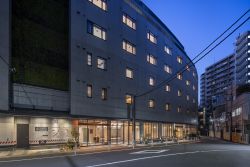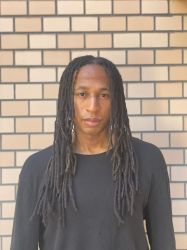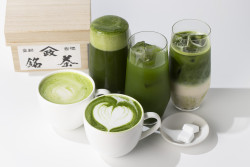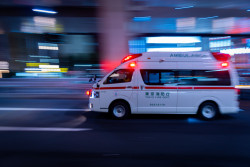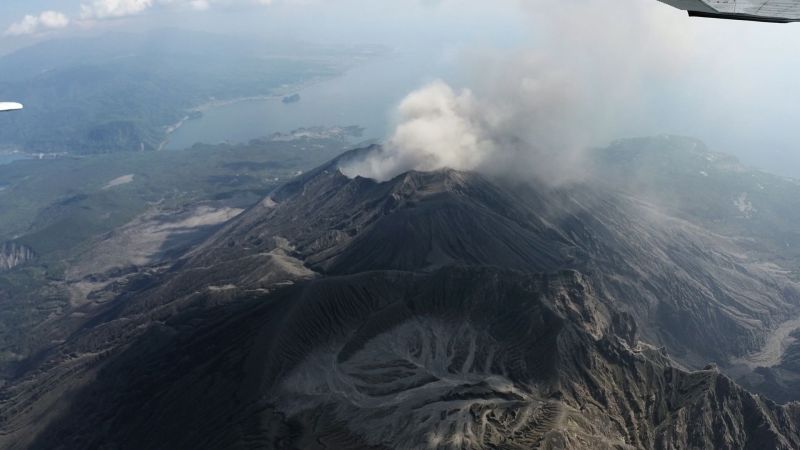
In the south of Japan lies the country’s most active volcano, which erupts at least 100 times a year. As a result, the island is often covered with volcanic ash, with smoke clouds looming over the sky. But surprisingly, a few people still choose to call this island home.
We joined Canadian YouTuber Norm Nakamura (TokyoLens) on a journey to the most active volcano in Japan. During our week-long quest in Sakurajima, we investigated what life is like in the harshest, most dangerous location in the country. We start this epic journey on the Sakurajima Ferry, which departs every 15 minutes from Kagoshima to Sakurajima, and vice versa, 24 hours a day.

Tucked into the bay of Kagoshima in Kyushu is an area many once called the pirate capital of Japan. Back in the Taisho era, the most catastrophic eruption took place in 1914. The magma from this eruption flowed down and solidified, connecting the island to the Kagoshima mainland.
Sakurajima means Cherry Blossom Island, an active stratovolcano island city in Kagoshima that measures 1,117 meters in height. The island is filled with evacuation centers, the streets with volcanic ash, and children wear helmets to school daily. Walking on the island, you’ll come across a shrine half-buried in ash, abandoned homes, hotels, boats and cars—relics reminiscent of a time when the island was once a thriving community.

We meet Volcano expert Daisuke Fukushima, who has lived in Sakurajima for over 20 years. “It is hazardous if you are up close to the volcano,” he explains, “but most rocks and debris only fall within a 2 km radius of the blast. Most homes here are over 4 km from the crater. Sakurajima has monitoring stations which record the seismic activity 24/7, and the data is fed to Kyoto University for analysis.”
“It feels like any other place. For example, if you think of areas with heavy snowfall or sand storms, technically, people should not live there, and yet they do. If anything, it’s pretty beautiful here, though you must be on your guard. It becomes effortless once it’s your second nature, like wearing a helmet. My kids wear helmets every day to school as there is always a chance of small rocks falling from the eruptions. It’s just a safety measure.”
“One of the biggest challenges of living here is the constant ash, which has a fine grain texture and is made from crushed volcanic rock,” he adds. “After an average eruption, volcanic ash comes raining down for about 10-20 minutes, and you occasionally have days where the volcanic ash rains on us all day. Every time the ash rains down from the sky, we start cleaning and packing it in special yellow bags. Then we put these at specialized pick-up points. Every resident here is given about 100 yellow bags for ash collection and disposal each year.”

Since ash is such a big problem in Sakurajima, even graves are constructed with roofs, and dump trucks hauling tons of ash are a common sight.
“The island’s population is declining,” Fukushima continues. “When I first moved here, there were about 7,000 people, and the population has shrunk to 3,000 now. As there are few jobs in Sakurajima, quite a few young people have relocated.” What’s bizarre is that current residents include not only those born and raised here, but also people from other areas of Japan who have chosen to relocate here and call this island of falling ashes home.
One example is a local mother from Fukuoka who tells us she has lived here for 13 years. “I thought moving here would be quite an adventure, to experience life on an active volcano. We often get calls from family and friends inquiring if we are OK after an eruption, but we have become so used to the eruptions over the years that we barely notice them. Of course, it is rare for most people to feel that way, but it’s normal for us. With my kids, I like to go to the beach on our days off. We don’t need to go anywhere special to have fun. Even just walking around the beach here is fun.”

A lady who feeds cats on the island’s backstreets also shares her story. “I moved from Imabari city in Ehime, Shikoku, because my husband was from here, but he passed away nine years ago. This is my home now. I have lived here for the past 12 or 13 years.”
“Initially, when I moved here, I was terrified and wanted to return home, but humans are peculiar, aren’t they? So as a few years went by, I got used to it. But when the eruptions happen, it is still quite scary for me.”
“Back in the day, people came here by ferry from Kagoshima to abandon their dogs. No matter where you were walking on the island, there were collared dogs, and my husband took care of all of them. I feel anyone can do that for a day or two–give them a little food and move on with their lives, but I am here 365 days a year. You can find me here feeding the cats even when it rains and snows. Even if everyone laughs, these little creatures have eyes, noses, mouths, feet and feelings just like us. I know they wait for me every day.”

A farmer we encounter at a vending machine tells us more about the potential risks of living on a volcano. “Most people have basic instincts warning them against danger, but people on this island just don’t seem to feel danger; their overall sense of what is dangerous is a little different from the rest of the world. I raise cows on the island; Sakurajima used to have a lot of cows, fish farmers, civil engineers, a few mikan farmers, and fruit orchard owners too.”
There is one restaurant and one café on the island. One medical center, one grocery store, two convenience stores (a Lawson, and a FamilyMart). The island has four elementary schools with around 100 students, but there are no high schools. Residents go to the mainland on a ferry for higher studies and in search of livelihood. Further down the road, a construction worker tells us that he has been here for so long that he barely notices when the eruption shakes his house. “Every once in a while, when I am driving, I see magma flying out of the volcano in my rear view mirror, and my first thoughts are of beautiful fireworks. It’s honestly come to that point. But, for me, it’s not scary anymore. Life on Sakurajima is pretty laid back. There is no pressure or rush; you just head home after work and watch the sunset with some sake. It’s the kind of place where you can live a slow life.”



